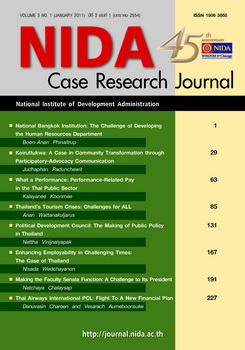Political Development Council: The Making of Public Policy in Thailand
Keywords:
Public Administration, Public Policy, Politics, Political Development, InstitutionsAbstract
After the bloodless revolution in June 24, 1932 that turned the absolute monarchy into a constitutional monarchy Thai political system has been unstable since. The popular participation is limited and the political development has been slow. While General (ret.) Surayud Chulanont was in his office as the 24th prime minister of Thailand (1 October 2006 – 29 January 2008), he appointed the Drafting Political Development Council Subcommittee under Prime Minister’s Office to create the Political Development Council (PDC) model with the appropriate structure, status, role and authority. The PDC missions are to better politics in constitutional monarchy system, promote political ethics and empower people.
The case writer was a researcher who analyzed and synthesized information from relevance documents, 32 hearing forums with almost 3,500 people around the country participated, seminars, workshops and interviews in order to propose the PDC model to the subcommittee. Later on, the model was passed through the political process for the National Legislative Assembly of Thailand to consider whether to pass the Political Development Council Act.
This case study focuses on what the National Legislative Assembly of Thailand should decide on the PDC structure, secretariat, sources of income, role and activities. What are the perspectives that the National Legislative Assembly of Thailand should take into consideration in designing the PDC.





